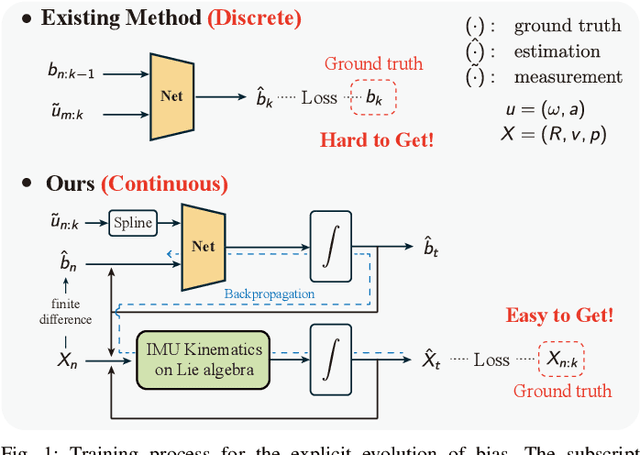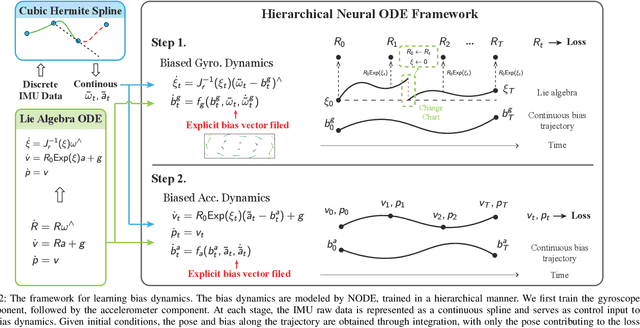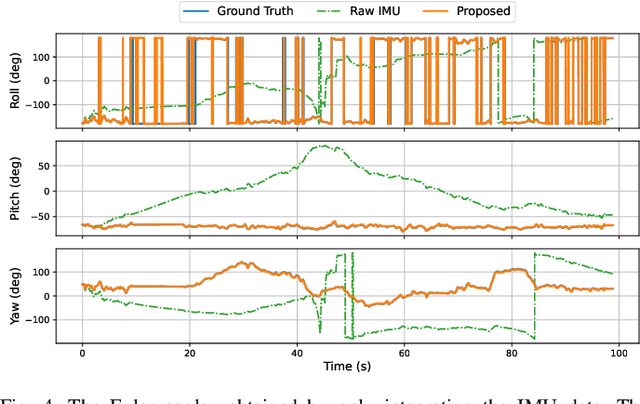Maani Ghaffari
University of Michigan
Equivariant Neural Networks for General Linear Symmetries on Lie Algebras
Oct 27, 2025Abstract:Encoding symmetries is a powerful inductive bias for improving the generalization of deep neural networks. However, most existing equivariant models are limited to simple symmetries like rotations, failing to address the broader class of general linear transformations, GL(n), that appear in many scientific domains. We introduce Reductive Lie Neurons (ReLNs), a novel neural network architecture exactly equivariant to these general linear symmetries. ReLNs are designed to operate directly on a wide range of structured inputs, including general n-by-n matrices. ReLNs introduce a novel adjoint-invariant bilinear layer to achieve stable equivariance for both Lie-algebraic features and matrix-valued inputs, without requiring redesign for each subgroup. This architecture overcomes the limitations of prior equivariant networks that only apply to compact groups or simple vector data. We validate ReLNs' versatility across a spectrum of tasks: they outperform existing methods on algebraic benchmarks with sl(3) and sp(4) symmetries and achieve competitive results on a Lorentz-equivariant particle physics task. In 3D drone state estimation with geometric uncertainty, ReLNs jointly process velocities and covariances, yielding significant improvements in trajectory accuracy. ReLNs provide a practical and general framework for learning with broad linear group symmetries on Lie algebras and matrix-valued data. Project page: https://reductive-lie-neuron.github.io/
Super LiDAR Reflectance for Robotic Perception
Aug 14, 2025Abstract:Conventionally, human intuition often defines vision as a modality of passive optical sensing, while active optical sensing is typically regarded as measuring rather than the default modality of vision. However, the situation now changes: sensor technologies and data-driven paradigms empower active optical sensing to redefine the boundaries of vision, ushering in a new era of active vision. Light Detection and Ranging (LiDAR) sensors capture reflectance from object surfaces, which remains invariant under varying illumination conditions, showcasing significant potential in robotic perception tasks such as detection, recognition, segmentation, and Simultaneous Localization and Mapping (SLAM). These applications often rely on dense sensing capabilities, typically achieved by high-resolution, expensive LiDAR sensors. A key challenge with low-cost LiDARs lies in the sparsity of scan data, which limits their broader application. To address this limitation, this work introduces an innovative framework for generating dense LiDAR reflectance images from sparse data, leveraging the unique attributes of non-repeating scanning LiDAR (NRS-LiDAR). We tackle critical challenges, including reflectance calibration and the transition from static to dynamic scene domains, facilitating the reconstruction of dense reflectance images in real-world settings. The key contributions of this work include a comprehensive dataset for LiDAR reflectance image densification, a densification network tailored for NRS-LiDAR, and diverse applications such as loop closure and traffic lane detection using the generated dense reflectance images.
Imaginative World Modeling with Scene Graphs for Embodied Agent Navigation
Aug 09, 2025Abstract:Semantic navigation requires an agent to navigate toward a specified target in an unseen environment. Employing an imaginative navigation strategy that predicts future scenes before taking action, can empower the agent to find target faster. Inspired by this idea, we propose SGImagineNav, a novel imaginative navigation framework that leverages symbolic world modeling to proactively build a global environmental representation. SGImagineNav maintains an evolving hierarchical scene graphs and uses large language models to predict and explore unseen parts of the environment. While existing methods solely relying on past observations, this imaginative scene graph provides richer semantic context, enabling the agent to proactively estimate target locations. Building upon this, SGImagineNav adopts an adaptive navigation strategy that exploits semantic shortcuts when promising and explores unknown areas otherwise to gather additional context. This strategy continuously expands the known environment and accumulates valuable semantic contexts, ultimately guiding the agent toward the target. SGImagineNav is evaluated in both real-world scenarios and simulation benchmarks. SGImagineNav consistently outperforms previous methods, improving success rate to 65.4 and 66.8 on HM3D and HSSD, and demonstrating cross-floor and cross-room navigation in real-world environments, underscoring its effectiveness and generalizability.
Registration beyond Points: General Affine Subspace Alignment via Geodesic Distance on Grassmann Manifold
Jul 24, 2025Abstract:Affine Grassmannian has been favored for expressing proximity between lines and planes due to its theoretical exactness in measuring distances among features. Despite this advantage, the existing method can only measure the proximity without yielding the distance as an explicit function of rigid body transformation. Thus, an optimizable distance function on the manifold has remained underdeveloped, stifling its application in registration problems. This paper is the first to explicitly derive an optimizable cost function between two Grassmannian features with respect to rigid body transformation ($\mathbf{R}$ and $\mathbf{t}$). Specifically, we present a rigorous mathematical proof demonstrating that the bases of high-dimensional linear subspaces can serve as an explicit representation of the cost. Finally, we propose an optimizable cost function based on the transformed bases that can be applied to the registration problem of any affine subspace. Compared to vector parameter-based approaches, our method is able to find a globally optimal solution by directly minimizing the geodesic distance which is agnostic to representation ambiguity. The resulting cost function and its extension to the inlier-set maximizing \ac{BnB} solver have been demonstrated to improve the convergence of existing solutions or outperform them in various computer vision tasks. The code is available on https://github.com/joomeok/GrassmannRegistration.
GPS-DRIFT: Marine Surface Robot Localization using IMU-GPS Fusion and Invariant Filtering
Jul 02, 2025Abstract:This paper presents an extension of the DRIFT invariant state estimation framework, enabling robust fusion of GPS and IMU data for accurate pose and heading estimation. Originally developed for testing and usage on a marine autonomous surface vehicle (ASV), this approach can also be utilized on other mobile systems. Building upon the original proprioceptive only DRIFT algorithm, we develop a symmetry-preserving sensor fusion pipeline utilizing the invariant extended Kalman filter (InEKF) to integrate global position updates from GPS directly into the correction step. Crucially, we introduce a novel heading correction mechanism that leverages GPS course-over-ground information in conjunction with IMU orientation, overcoming the inherent unobservability of yaw in dead-reckoning. The system was deployed and validated on a customized Blue Robotics BlueBoat, but the methodological focus is on the algorithmic approach to fusing exteroceptive and proprioceptive sensors for drift-free localization and reliable orientation estimation. This work provides an open source solution for accurate yaw observation and localization in challenging or GPS-degraded conditions, and lays the groundwork for future experimental and comparative studies.
Riemannian Direct Trajectory Optimization of Rigid Bodies on Matrix Lie Groups
May 05, 2025



Abstract:Designing dynamically feasible trajectories for rigid bodies is a fundamental problem in robotics. Although direct trajectory optimization is widely applied to solve this problem, inappropriate parameterizations of rigid body dynamics often result in slow convergence and violations of the intrinsic topological structure of the rotation group. This paper introduces a Riemannian optimization framework for direct trajectory optimization of rigid bodies. We first use the Lie Group Variational Integrator to formulate the discrete rigid body dynamics on matrix Lie groups. We then derive the closed-form first- and second-order Riemannian derivatives of the dynamics. Finally, this work applies a line-search Riemannian Interior Point Method (RIPM) to perform trajectory optimization with general nonlinear constraints. As the optimization is performed on matrix Lie groups, it is correct-by-construction to respect the topological structure of the rotation group and be free of singularities. The paper demonstrates that both the derivative evaluations and Newton steps required to solve the RIPM exhibit linear complexity with respect to the planning horizon and system degrees of freedom. Simulation results illustrate that the proposed method is faster than conventional methods by an order of magnitude in challenging robotics tasks.
Debiasing 6-DOF IMU via Hierarchical Learning of Continuous Bias Dynamics
Apr 13, 2025



Abstract:This paper develops a deep learning approach to the online debiasing of IMU gyroscopes and accelerometers. Most existing methods rely on implicitly learning a bias term to compensate for raw IMU data. Explicit bias learning has recently shown its potential as a more interpretable and motion-independent alternative. However, it remains underexplored and faces challenges, particularly the need for ground truth bias data, which is rarely available. To address this, we propose a neural ordinary differential equation (NODE) framework that explicitly models continuous bias dynamics, requiring only pose ground truth, often available in datasets. This is achieved by extending the canonical NODE framework to the matrix Lie group for IMU kinematics with a hierarchical training strategy. The validation on two public datasets and one real-world experiment demonstrates significant accuracy improvements in IMU measurements, reducing errors in both pure IMU integration and visual-inertial odometry.
POp-GS: Next Best View in 3D-Gaussian Splatting with P-Optimality
Mar 10, 2025Abstract:In this paper, we present a novel algorithm for quantifying uncertainty and information gained within 3D Gaussian Splatting (3D-GS) through P-Optimality. While 3D-GS has proven to be a useful world model with high-quality rasterizations, it does not natively quantify uncertainty. Quantifying uncertainty in parameters of 3D-GS is necessary to understand the information gained from acquiring new images as in active perception, or identify redundant images which can be removed from memory due to resource constraints in online 3D-GS SLAM. We propose to quantify uncertainty and information gain in 3D-GS by reformulating the problem through the lens of optimal experimental design, which is a classical solution to measuring information gain. By restructuring information quantification of 3D-GS through optimal experimental design, we arrive at multiple solutions, of which T-Optimality and D-Optimality perform the best quantitatively and qualitatively as measured on two popular datasets. Additionally, we propose a block diagonal approximation of the 3D-GS uncertainty, which provides a measure of correlation for computing more accurate information gain, at the expense of a greater computation cost.
Discrete-Time Hybrid Automata Learning: Legged Locomotion Meets Skateboarding
Mar 03, 2025Abstract:This paper introduces Discrete-time Hybrid Automata Learning (DHAL), a framework using on-policy Reinforcement Learning to identify and execute mode-switching without trajectory segmentation or event function learning. Hybrid dynamical systems, which include continuous flow and discrete mode switching, can model robotics tasks like legged robot locomotion. Model-based methods usually depend on predefined gaits, while model-free approaches lack explicit mode-switching knowledge. Current methods identify discrete modes via segmentation before regressing continuous flow, but learning high-dimensional complex rigid body dynamics without trajectory labels or segmentation is a challenging open problem. Our approach incorporates a beta policy distribution and a multi-critic architecture to model contact-guided motions, exemplified by a challenging quadrupedal robot skateboard task. We validate our method through simulations and real-world tests, demonstrating robust performance in hybrid dynamical systems.
Learning Implicit Social Navigation Behavior using Deep Inverse Reinforcement Learning
Jan 12, 2025Abstract:This paper reports on learning a reward map for social navigation in dynamic environments where the robot can reason about its path at any time, given agents' trajectories and scene geometry. Humans navigating in dense and dynamic indoor environments often work with several implied social rules. A rule-based approach fails to model all possible interactions between humans, robots, and scenes. We propose a novel Smooth Maximum Entropy Deep Inverse Reinforcement Learning (S-MEDIRL) algorithm that can extrapolate beyond expert demos to better encode scene navigability from few-shot demonstrations. The agent learns to predict the cost maps reasoning on trajectory data and scene geometry. The agent samples a trajectory that is then executed using a local crowd navigation controller. We present results in a photo-realistic simulation environment, with a robot and a human navigating a narrow crossing scenario. The robot implicitly learns to exhibit social behaviors such as yielding to oncoming traffic and avoiding deadlocks. We compare the proposed approach to the popular model-based crowd navigation algorithm ORCA and a rule-based agent that exhibits yielding.
 Add to Chrome
Add to Chrome Add to Firefox
Add to Firefox Add to Edge
Add to Edge